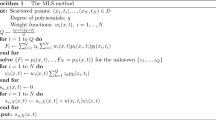Abstract
For non-homogeneous and nonlinear problems, a major difficulty in applying the Boundary Element Method is the treatment of the volume integrals that arise. A recent proposed method, the grid-based integration method (GIM), uses a 3-D uniform grid to reduce the complexity of volume discretization, i.e., the discretization of the whole domain is avoided. The same grid is also used to accelerate both surface and volume integration. The efficiency of the GIM has been demonstrated on 3-D Poisson problems. In this paper, we report our work on the extension of this technique to quasilinear problems. Numerical results of a 3-D Helmholtz problem and a quasilinear Laplace problem on a multiply-connected domain with Dirichlet boundary conditions are presented. These results are compared with analytic solutions. The performance of the GIM is measured by plotting the L2-norm error as a function of the overall CPU time and is compared with the auxiliary domain method in the Helmholtz problem.
Similar content being viewed by others
References
Ahmed S, PK Banerjee (1986) Free vibration analysis of BEM using particular integrals. J Engi. Mech. 112:682–695
Ding J, Ye W, Gray L (2005) An accelerated surface discretization based BEM approach for non-homogeneous linear problems in 3-D Complex Domains. Int J Numer Meth Eng 63 (12): 1775–1795
Gao XW (2002) The radial integration methods for evaluation of domain integrals with boundary-only discretization. Engi. Anal Bound Ele, 26:905–916
Gao XW (2003) Boundary element analysis in thermoelasticity with and without Internal Cells. Int J Numer Meth Eng 57(7):975–990
Gao XW, TG Davies (2002) Boundary element programming in mechanics, Cambridge University Press, Cambridge
Gao XW (2005) Evaluation of regular and singular domain integrals with boundary-only discetization - theory and Fortran code, J Comput Appl Math 175(2):265–290
Goldberg MA, Chen CS, Bowman H, Power H (1998) Some comments on the use of radial basis functions in the dual reciprocity method. Comput Mech 21(2):141–148
Herry D, Banerjee PK (1988) A New boundary element formulation for two- and three-dimensional thermoelasticity using particular Integrals. Int J Numer Meth Eng 26:2061–2077
Hsiao SC, Mammoli AA, Ingber MS (2003) The evaluation of domain Integrals in complex multiply-connected three-dimensional geometries for boundary element methods. Comput Mech 32:226–233
Ingber MS (1987) An efficient boundary element method for a class of parabolic differential equations using discretization in time. Numer Meth Part D Eq 3(3):187–197
Ingber MS, Phan-Thien N (1992) A Boundary element approach for parabolic differential equations using a Class of Particular Solutions. Appl Math Model 16(3):124–132
Ingber MS (1994) A Triple reciprocity boundary element method for transient heat conduction analysis, Int Conference on Boundary Ele Technol pp 41–49
Ingber MS, Mammoli A, Brown M (2001) A Comparison of domain integral evaluation techniques for boundary element methods. Int J Numer Meth Eng 52(4):417–432
Katsikadelis JT, Nerantzaki MS (1999) The boundary element methods for nonlinear problems. Eng Anal Boun Ele 23:365–373
Mammoli AA (2002) Solution of Non-Linear integral equations in complex geometries with auxiliary integral subtraction. Int J Numer Meth Eng 55:1115–1128
Master N, Ye W (2004) Fast BEM solution for coupled 3D electrostatic and linear elastic problems,'' Eng Anal Bound Ele 28(9):1175–1186
Nardini D, Brebbia CA (1983) A New approach to free vibration analysis using boundary elements. Appl Mathe Model 7(3):157–162
Nowak AJ, Brebbia CA (1989) The multiple-reciprocity method. A new approach for transforming BEM domain integrals to the boundary. Eng Anal Bound Ele 6(3):164–167
Partridge PW, Brebbia CA, Wrobel LC (1992) The Dual Reciprocity Bound Ele Meth Elsevier, London
Phillips JR, White J (1997) A Precorrected-FFT Method for Electrostatic Analysis of Complicated 3-D Structures. IEEE Transactions on Computer-Aided Design of Integrated Circuits and System, 16(10):1059–1072
Zhang JJ, Afagh FF and Tan CL (1996) Boundary integral transformation of body-force volume integral in BEM for 2d Anisotropic elasticity. Mach Rese Commu 23(2):227–232
Author information
Authors and Affiliations
Corresponding author
Rights and permissions
About this article
Cite this article
Ding, J., Ye, W. A Grid-based integral approach for quasilinear problems. Comput Mech 38, 113–118 (2006). https://doi.org/10.1007/s00466-005-0724-z
Received:
Accepted:
Published:
Issue Date:
DOI: https://doi.org/10.1007/s00466-005-0724-z




